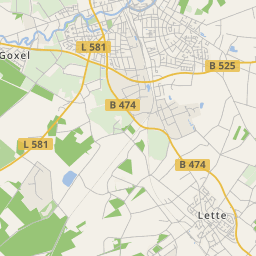












The district town of Coesfeld is situated around 35 km west of Münster and thus right in the middle of the Münsterland, which is being framed by the Teutoburger Forest, the Soester Börde and the Dutch border. With the Coesfelder Hill, part of the city area is situated in the Baumbergen, where the stream Berkel has its source near Billerbeck. It flows through Coesfeld, but is being dammed at the Walkenbrückentor to flow, to a large extend inside the embankments, outside the ring, around the city. The nature resort Hohe Mark is situated south of Coesfeld.

The first written mention of Coesfeld can be found in the biography of the holy Ludgerus, patron saint and bishop of Münster's diocese. Then, Liudger preached in the St. Lamberti church on his way from his abbey in Essen/Werden to Münster, on the eve before his death on the 26th of March 809. In the year 1197, bishop Hermann II. von Katzenelnbogen of Münster transferred the town charter to Coesfeld, a few years after the neighbouring village Münster became a town, thus the new town was released from the disputed dependance from the monastery Varlar, located near Coesfeld.

Heinrich (of Coesfeld), as the second provost of the monastery Varlar, which was founded by his relatives Gottfried and Otto von Cappenberg with the participation of Norbert von Xanten, as a Premonstratensian monastery, bequeathed the village Coesfeld, located north of the river Berkel, just before it became a town. By building a new church, the Jacobi church, south of the river Berkel, the bishop of Münster was able to claim its own (town-) rights. The received deed carries the date of the 12th of March 1197, the deed, then got the imperial confirmation the following August. The new status was linked with significantly extended rights of the citizens, but which were named specifically. Part of the rights were probably market sovereignty, the prerogative of coinage, fiscal sovereignty, its own jurisdiction and free election of the mayor and lay judges as well as the right of fortification. Of the formerly four main fairs, only the Ursula market as well as the farmer's market have survived till today, taking place on Mondays and Thursdays. In the year 1244, the Cistercienserian monastery Marienborn was relocated to Coesfeld.

The prince-bishop of Münster, Franz von Waldeck, at the siege of the Anabaptist Kingdom of Münster. In 1534, it was possible, for a short time, to win considerable influence in the then Protestant Coesfeld and further cities in the Münsterland, with the help of 'emissaries', which were sent from Münster by the theocratic 'baptists'. The Baptists, whose Münster leader Jan van Leiden and Jan Matthys originated from the Netherlands and the ideological leader Bernd Rothmann from Stadtlohn, were forced out by the bishop Franz von Waldeck with help troops.

Coesfeld was extensively destroyed by bombs, shortly before the end of the 2nd World War, then it was occupied by the advancing British-American troop under Bernard Montgomery. During the following rebuilding – in parts car-friendly – were large areas integrated onto the townscape's centre and the town experienced an economical boom for decades. On the 1st of July 1969, Coesfeld's city centre was merged with the formerly independent community Coesfeld parish, which was - determined by the Prussian revised city regulations from 1831 - separated from the town since 1837, thus the population grew from 22.039 to 26.528. At the communal restructuring of the districts, Coesfeld kept its status as county headquarter. The city of Coesfeld and the surrounding district survived Westphalia's textile crisis in the 1970ties smoothly through the settling of new small and medium-sized enterprises. In the year 1997, Coesfeld celebrated the town's 800-year existence.